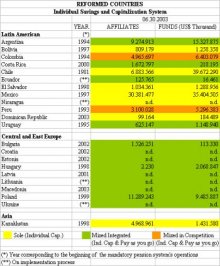CHILE |
La Segunda Newspaper
Worldwide longevity increase will swell retirement figures.
The President of the AFP Association and the International Federation of Pension Funds Management Companies, Guillermo Arthur, is emphatic when pointing out that the distribution systems that still operate in many countries are unsustainable.
“A United Nations study reveals that in the 1950 - 1955 period, the distribution system operating in Chile took 14 workers to support the pension of one individual; this rate came down to 10 in the 1990 - 1995 period and it is expected that in the 2020 - 2025 period there would be just 6 active workers for each retiree, which would demand a 130% increase in contribution rates to keep pensions level with average salaries”, said Guillermo Arthur.
These are the current circumstances in the leading European economies. The World Bank indicates that in 2040 there will be only two workers for each retiree in the 15 countries that make up the European Union. The present rate is four to one. The United States, with a younger population and an immense foreign work force that will remain large as long as the country keeps admitting close to one million new immigrants every year, the current 5 - 1 proportion will come down to just 3 - 1 in 2040.
According to Guillermo Arthur, there are two ways to deal with this problem: with parametric reforms or with an individual capitalization system like the Chilean regimen. The first alternative implies postponement of the retirement age, discouraging advanced retirement, hardening pensioning requisites and increasing contributions. “But every one of these measures have a high political cost and this is why many governments choose to defer their implementation”, he declared.
“On the other hand, the advantage of individual capitalization systems is that they automatically make all these adjustments without any pressures on the political economy”, added Guillermo Arthur.
But this is not the only advantage; Arthur affirms, “pension amounts have shown considerable improvement, because pension funds returns have exceeded the salary index. In order to get a pension close to 70% of remuneration, a 4% average annual yield is required. In Chile, the average annual pension funds return has been close to 10%”.
The progressive worldwide crisis of distribution systems has confronted many governments with reforms based on savings and individual capitalization to support old age pensions. Arthur concludes that this is the way to reduce evasion, set up a relationship between pensions and personal effort, increase national savings and stimulate economic development in the countries that implement it.
In this context, the Chilean model implemented in 1981 has been taken as an example by many countries (see table).
November 6, 2003

